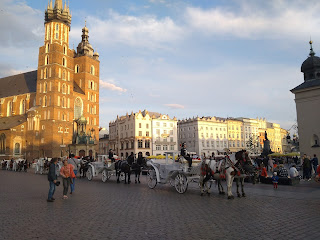Let's go to Noia! Sounds funnier in Galician because it's like ¨let's go, paranoia!¨
Even though plane rides for me are out of the question these days, living in Galicia (aka
Galifornia) means there are still plenty of awesome getaway options close to home. This weekend we visited Noia and its surroundings, smack dab in the middle of Galicia's west coast.
 |
San Martiño and its cursed,
unfinished tower |
Noia's Old Town is true to its name, full of beautiful sandstone buildings (including
pazos!) dating back to the Middle Ages and beyond. A place to remind me,
I'm in Europe! Everything is historic here! We spent our first evening there walking around the pedestrian-only center. There are two noteworthy churches. San Martiño is lopsided, and legend has it that whoever tries to build the second tower is met with a grim demise. Apparently the original builder died before it could be finished, and then a movie director who had had a fake tower constructed for the sake of his film died on the last day of shooting. The other church, Santa Mariña A Nova, has a tremendous collection of stone tomb covers. They are carved with symbols either associated with the person's trade or the family crest. Very cool! The adjoined cemetery is also for some reason one of the most important in Spain.
 |
| Old hydroelectric plant by Palacios |
A few miles inland from Noia are more natural and man-made landmarks. First, an early morning (by Spanish standards) visit to the still-active hydroelectric plant. Well, we got a bit lost and actually walked around the current plant when what we really wanted to see was the original building from the 1920s. It was designed by Antonio Palacios, the same Galician who went on to design-- among other things--
O Carballiño's unexpectedly large cathedral ; the
Palacio de Cibeles, Madrid's current city hall; and the
hotel at the Spa in Mondariz. When we finally located the building and surrounding park, it was so peaceful. The river was completely still. The only other people there were a handful of fishermen. There are three possible hikes starting from the park, but we stuck to crossing the small suspension bridge and walking along the river for a few minutes before going back. Just in time, because although it was sunny it had started to drizzle.
Long before the Tambre River's power was harnessed to create electricty, it was a place to fish. (It still is, as a matter of fact.) Especially lamprey. In the Middle Ages this specific section of the river supplied a local monastery with fish. And that was our next stop: San Xusto de Toxosoutos. This time there was a marked trail which I assumed led to the waterfall I had read about while researching the area. We trekked mostly downhill for about an hour, and still no waterfall in sight. We decided to turn around as we weren't exactly prepared for a hike, and certainly weren't convinced that it actually led to the waterfall. Lo and behold, once we made it back up the hill to the monastery, we discovered the waterfall was actually right behind the monastery, in the opposite direction of our little trek. Oops. But hey, at least we got some exercise in before lunch. Right in front of the beach we ate cockles --Noia's specialty-- and squid
croquetas. Black like tar, but a thousand times tastier!
 |
| Tranquilidade: Mosteiro de Toxosoutos |
After lunch we were set to carry out my favorite coastal ritual: the beach nap. But once we put our towels down on the beach in front of the restaurant, the wind picked up and grey clouds covered the sky. We packed up, and although I was so sleepy and grumpy I just wanted to go back to the hotel, we drove in search of those clear, blue skies that could be seen beyond the rain clouds. Amazingly, after about 30 minutes, we did indeed find a beach under the sun! And what a beach to come across--
A Praia das Furnas. This ¨beach of caverns or grottoes¨ has massive, dark rock formations which create a small watering hole protected from the wild sea. Handy because the constant white-capped waves sure made the scenery picture-perfect, but after going in only up to my ankles, I could feel the tide wanted to drag me away. And technically it's not even part of the Costa da Morte (the Death Coast)! In addition to the beach's beauty, it is well-known as the place where Ramón Sampedro (who the movie Mar Adentro is based on) became quadriplegic after an accident.
 |
On top of the crag/cavern, the ocean below in the background,
small pool in the foreground |
On Sunday we wrapped up our getaway at Noia's outdoor market. Suddenly the Old Town and riverside were full of dozens of stands selling everything from apparel to kitchenware to food. It wasn't too crowded, so everyone could practice social distancing while perusing the wares. A burger at yet another beach bar-- empty because of the gusty wind-- was our last hoorah in Noia before heading home.














